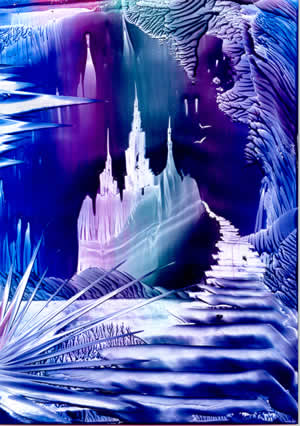




 |
 |
 |
 |
 |
DEVELOPMENT |
ONLINE
PROJECTS |
|||||
| Fantasy Scry: imaginary underworlds using the iron ... | |
 |
Scrying is short for DESCRY which is defined as:
This is a great approach for imaginative visions and fantasy art. Encaustic art is an ideal medium for this type of activity because it is so easy to change the background effects until "something" catches your eye and imagination. Strong dark colours work well and these magical hues are very popular for the underworlds they produce. |
 |
Start by getting the three magical colours together: Put a band of |
 |
Now spread these in an easy movement down the entire length of an A6 encaustic painting card, keeping the colours in their bands as you do so. |
 |
There are several possible ways to work over this initial spread of colour. Sometimes the very first application can create such an interesting and attractive background that you need do no more. However, lots of the time you need to get back on top of the wax and work at it a bit harder.
|
 |
SLOW MOVEMENTS over the wax tend to yield smooth results |
 |
FASTER SMOOTHING SPEED will create more texture |
 |
The results are normally streaks and trails of darker colour , which can make interesting starting points for your imaginative journeys. |
 |
The wax can be worked over many times, but slowly the bands of colour do merge and combine. DRAG TECHNIQUES combine a slight lifting of the iron's back edge with ... |
 |
... a long drawn out pull away from the table surface - a bit like an aircraft taking off. It is vital that the back edge of the iron is not touching the card as it passes over. This is to allow the wax to "drool and dribble" off the actual base plate in a more random form, rather than be squashed into a more uniform result by the flat straight back edge of the iron, which is what happens if it is in contact. |
 |
These "trails" of wax give lots of food for the imagination. |
 |
.... and turn out differently every time. |
 |
WHAT COULD THIS BE TURNED INTO? |
 |
Keep going over the card and wax lightly until you are inspired to stop and use the effect that has been formed by your work. |
 |
If you are not content with the card one way up, then ... |
 |
... try turning it upside down and seeing what you can find there. This result looks ideal for some castles, where the white light inner area will become the foundations. These can be elaborated upon by the scribing tool later. |
 |
First some surroundings to make the image more 3d and bring greater depth to the picture. Just dab around the card's edges to make some foliage type effects. |
 |
Already we have a foreground and some distance, but there is still much to do to create greater illusion of depth. |
 |
Adding a plain area will always create the impression of space, so using the iron's edge to scrape out some colour and encourage the concept of water is appealing. |
 |
Now we have foreground foliage, water in the middle distance, a subject in the far distance and a dark background to it all. |
 |
Use the scribing tool to etch away some of the wax ... |
 |
... here drawing lines parallel to the vertical edges of the card for improved castle spires. |
 |
Adding more spires to pull a believable image out of the wax background. |
 |
Until you are content that enough has been done to carry of the illusion. |
 |
There it is, a castle sitting pretty on the other side of the lake. |
 |
But how do we get the observer to walk into the picture and travel over to that castle? A path way is a great mechanism for adding dimensional depth to an image. |
 |
Scrape away horizontal lines - parallel to the bottom edge of the card. These recede in size and power as they get higher up the card as they become, in our illusion at least, further away. |
 |
The front part of the pathway looks a bit rough, so if you use the tip of the iron to run across the lines working from the higher starting point ... |
 |
... down towards the lowest edge of the card, then steps of a more 3D nature emerge. |
 |
Now there is a link from front to back. A way to travel into the illusion and become involved in the inner world of this illusion. |
 |
Add a bit of mystic "stuff" coming in from the side - achieved here by sliding in the straight side of the iron a few time. |
 |
Fiddle about with a few final scribed in details - birds and a few spots for some distant stars. |
 |
Give the whole thing a gentle wipe over to remove and tiny bits of wax shard scraped out during the scribing work, then polish softly and briskly, to create a nice sheen. |
 |
Magic - a place from nowhere, created from some background effects that could have taken your imagination in many diverse directions. Scrying really is a magical process that both absorbs and surprises. Try it and you may well be surprised at what happens. |
|